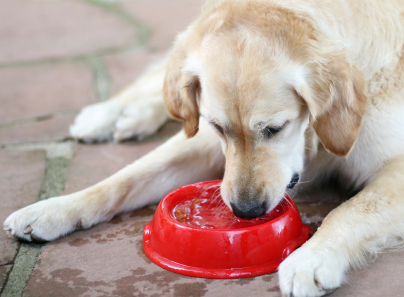In dogs with Cushing’s disease the adrenal glands overproduce some of the body’s regulators, particularly cortisol.
What are the signs of Cushing’s disease?
 The most common signs of Cushing’s disease are marked increases in appetite, water consumption and urination. Lethargy, panting and a poor hair coat are also common. We often see a pot-bellied or bloated abdomen due to increased fat within the abdominal organs and thinning of the muscular abdominal wall.
The most common signs of Cushing’s disease are marked increases in appetite, water consumption and urination. Lethargy, panting and a poor hair coat are also common. We often see a pot-bellied or bloated abdomen due to increased fat within the abdominal organs and thinning of the muscular abdominal wall.
What causes Cushing’s disease?
The three major causes of Cushing’s Disease:
- A tumour of the pituitary gland, that stimulates the adrenal glands to produce excessive amounts of cortisol.
- Excessive administration of synthetic cortisones cortisones such as prednisolone, triamcinolone or dexamethasone may cause Iatrogenic Cushing’s disease.
- An adrenal gland tumour is an uncommon cause of Cushing’s Disease.
If we suspect Cushing’s Disease we run a blood test to check your dog’s general health. An enzyme called Alkaline Phosphatase (ALKP) is often high in dogs with Cushing’s disease. A Low Dose Dexamethasone test (LDDT) confirms or denies Cushing’s disease.
To determine which type of Cushing’s disease your pet has, we ultrasound the adrenal glands and/or do an endogenous ACTH blood test.
What are the treatment options?
Pituitary Tumour: This is the most common cause of Cushing’s disease. There are two treatment options for it. Trilostane is our drug of choice. A daily capsule of Trilostane reduces the production of cortisone and another important hormone, aldosterone. We monitor your dog’s response to Trilostane with a test called the ACTH stimulation test. Too little Trilostane won’t reduce appetite or water consumption but too much will cause illness.
If your dog has liver or kidney disease we may suggest treatment with Mitotane (also known as Lysodren). This drug destroys part of the adrenal gland. Careful monitoring and good communication with your vet is necessary during the initial intensive treatment to achieve good results and avoid life-threatening adrenal damage.
Although the pituitary tumour remains present and continues to stimulate the adrenal gland if the tumour is small successful control for many years in most dogs is possible. If the tumour is large, it may invade surrounding brain tissue and cause other signs, but this is rare.
Iatrogenic Cushing’s Disease: To treat this type of Cushing’s disease we must stop the synthetic cortisone in a very controlled way. If we stop intensive cortisone treatment abruptly your dog may lose his appetite, vomit, develop diarrhea and collapse. The suppressed adrenal gland takes a while to regain normal production of cortisol.
Treatment of an Adrenal Tumour:
Adrenal tumours tend to invade surrounding tissue but if we can surgically remove it all and it is not malignant your dog will regain normal health. Otherwise we treat adrenal tumours with Trilostane also.

 Cortisone
Cortisone